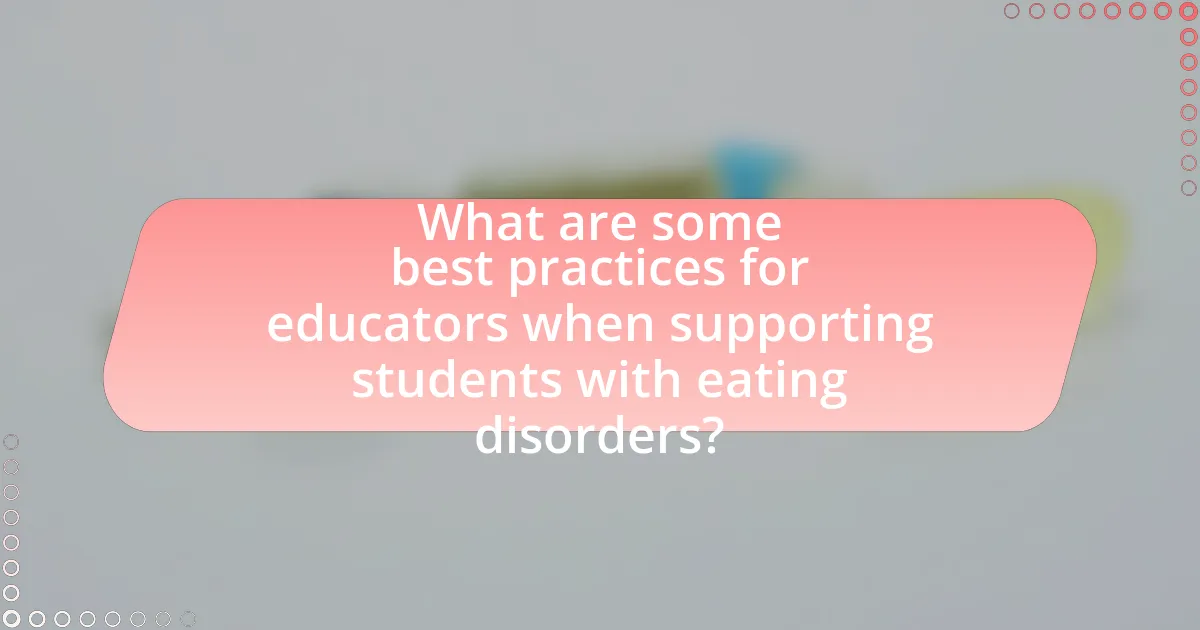The article focuses on strategies for educators to support students with eating disorders, emphasizing the importance of creating a safe and supportive environment, promoting open communication, and collaborating with mental health professionals. It outlines key indicators for identifying students who may be struggling, such as behavioral changes and emotional distress, and provides guidance on how to approach conversations about eating disorders. Additionally, the article discusses the role of the school environment in fostering mental health, the implementation of supportive policies, and the resources available for educators. It highlights best practices for developing individualized support plans and the significance of promoting healthy body image and self-esteem among students.

What are the key strategies for educators to support students with eating disorders?
Educators can support students with eating disorders by fostering a safe and supportive environment, promoting open communication, and collaborating with mental health professionals. Creating a safe space allows students to feel comfortable discussing their challenges, which is crucial for their recovery. Open communication encourages students to express their feelings and concerns without fear of judgment, facilitating better understanding and support from educators. Collaboration with mental health professionals ensures that educators are equipped with the necessary resources and strategies to address the specific needs of students, as research indicates that a multidisciplinary approach significantly improves outcomes for students with eating disorders.
How can educators identify students who may be struggling with eating disorders?
Educators can identify students who may be struggling with eating disorders by observing significant changes in behavior, physical appearance, and emotional well-being. Specific indicators include noticeable weight fluctuations, preoccupation with food, dieting, or body image, as well as withdrawal from social activities and changes in academic performance. Research indicates that approximately 30% of adolescents with eating disorders exhibit these behavioral changes, making early identification crucial for intervention. Additionally, educators should be aware of students expressing anxiety or distress related to meals or physical education classes, as these can be strong indicators of underlying issues.
What signs and symptoms should educators look for in students?
Educators should look for signs and symptoms such as significant weight loss, changes in eating habits, excessive exercise, and withdrawal from social activities in students. These indicators can suggest the presence of eating disorders. Research indicates that approximately 30% of adolescents with eating disorders exhibit noticeable behavioral changes, including preoccupation with food, body image issues, and mood swings. Recognizing these signs early can facilitate timely intervention and support for affected students.
How can educators approach conversations about eating disorders with students?
Educators can approach conversations about eating disorders with students by creating a safe and supportive environment that encourages open dialogue. This involves actively listening to students’ concerns, using empathetic language, and providing accurate information about eating disorders to dispel myths. Research indicates that early intervention and supportive communication can significantly improve outcomes for students struggling with these issues, as highlighted in the National Eating Disorders Association’s guidelines, which emphasize the importance of understanding and compassion in these discussions.
What role does the school environment play in supporting students with eating disorders?
The school environment plays a crucial role in supporting students with eating disorders by fostering a safe and inclusive atmosphere that promotes mental health awareness and provides access to resources. Schools can implement programs that educate staff and students about eating disorders, reducing stigma and encouraging open discussions. Research indicates that supportive school environments, characterized by understanding teachers and peer support, significantly improve the well-being of students facing these challenges. For instance, a study published in the Journal of School Health found that schools with comprehensive mental health programs reported better outcomes for students with eating disorders, highlighting the importance of a proactive approach in educational settings.
How can a positive school culture impact students’ mental health?
A positive school culture significantly enhances students’ mental health by fostering a supportive and inclusive environment. This environment reduces stress and anxiety, promoting emotional well-being. Research indicates that schools with a positive culture experience lower rates of bullying and higher levels of student engagement, which are critical factors in mental health. For instance, a study published in the Journal of School Psychology found that students in supportive school climates reported better mental health outcomes, including lower levels of depression and anxiety. Thus, a positive school culture directly correlates with improved mental health among students.
What policies can schools implement to create a supportive environment?
Schools can implement anti-bullying policies, mental health support initiatives, and inclusive education practices to create a supportive environment for students with eating disorders. Anti-bullying policies establish a zero-tolerance stance against harassment, which is crucial as bullying can exacerbate the struggles of students with eating disorders. Mental health support initiatives, such as access to counselors and training for staff on recognizing and addressing eating disorders, provide essential resources for affected students. Inclusive education practices, including awareness programs and sensitivity training, foster an understanding atmosphere that encourages acceptance and support among peers. Research indicates that schools with comprehensive mental health programs see improved student well-being and academic performance, highlighting the effectiveness of these policies in creating a nurturing environment.
What resources are available for educators to assist students with eating disorders?
Educators can access various resources to assist students with eating disorders, including professional training programs, counseling services, and educational materials. Organizations such as the National Eating Disorders Association (NEDA) provide comprehensive resources, including toolkits for educators, guidelines for recognizing signs of eating disorders, and strategies for intervention. Additionally, the Academy for Eating Disorders offers webinars and workshops focused on best practices for supporting students. Research indicates that early intervention and awareness can significantly improve outcomes for students struggling with these issues, highlighting the importance of utilizing these resources effectively.
How can educators collaborate with mental health professionals?
Educators can collaborate with mental health professionals by establishing regular communication channels to discuss student needs and share observations. This collaboration can include joint training sessions, where educators learn about mental health issues, including eating disorders, and mental health professionals gain insights into the educational environment. Research indicates that such partnerships enhance the identification and support of students facing mental health challenges, leading to improved academic and emotional outcomes. For instance, a study published in the Journal of School Psychology found that schools with integrated mental health services reported better student engagement and lower rates of absenteeism.
What educational materials can help raise awareness about eating disorders?
Educational materials that can help raise awareness about eating disorders include brochures, informational websites, documentaries, and educational workshops. Brochures provide concise information on the signs, symptoms, and resources available for individuals affected by eating disorders, making them accessible for quick reference. Informational websites, such as those maintained by the National Eating Disorders Association, offer comprehensive resources, including articles, personal stories, and helplines, which can educate both students and educators. Documentaries, like “To the Bone,” illustrate the personal experiences of those with eating disorders, fostering empathy and understanding. Educational workshops can be conducted in schools to engage students in discussions about body image, mental health, and the impact of societal pressures, thereby promoting a supportive environment. These materials collectively contribute to a well-rounded approach to raising awareness and understanding of eating disorders in educational settings.
How can educators effectively communicate with parents about their child’s eating disorder?
Educators can effectively communicate with parents about their child’s eating disorder by initiating open, empathetic conversations that focus on the child’s well-being. This approach involves scheduling a private meeting to discuss observations regarding the child’s behavior and health, using specific examples to illustrate concerns. Research indicates that clear communication fosters collaboration; for instance, a study published in the Journal of School Nursing highlights that when educators share detailed observations and express genuine concern, parents are more likely to engage in discussions about treatment options. By providing resources and suggesting professional help, educators can support parents in understanding the seriousness of the situation, ultimately leading to a more coordinated effort in addressing the child’s needs.
What strategies can educators use to initiate conversations with parents?
Educators can initiate conversations with parents by scheduling regular meetings and utilizing communication tools such as emails or newsletters. These strategies foster an open dialogue about students’ well-being, particularly in the context of supporting those with eating disorders. Research indicates that consistent communication between educators and parents enhances student support systems, as highlighted in the study “The Role of Family in the Treatment of Eating Disorders” by Le Grange et al. (2015), which emphasizes the importance of parental involvement in addressing eating disorders.
How can educators provide support to parents of students with eating disorders?
Educators can provide support to parents of students with eating disorders by facilitating open communication and offering resources for professional help. By establishing regular check-ins with parents, educators can create a supportive environment where parents feel comfortable discussing their concerns and challenges. Additionally, educators can share information about local mental health services, support groups, and educational materials that specifically address eating disorders, which can empower parents to seek appropriate assistance for their children. Research indicates that parental involvement is crucial in the recovery process, as it fosters a collaborative approach to treatment and reinforces positive behaviors at home.
What information should educators share with parents regarding available resources?
Educators should share information about mental health resources, counseling services, and educational materials related to eating disorders with parents. These resources can include local mental health clinics, school counseling services, and online platforms that provide information on recognizing and addressing eating disorders. For instance, the National Eating Disorders Association offers a helpline and educational resources that can help parents understand the signs and symptoms of eating disorders, as well as strategies for supporting their children. Sharing this information empowers parents to take proactive steps in addressing their child’s needs and fosters a collaborative approach between home and school.
How can educators advocate for students with eating disorders within the school system?
Educators can advocate for students with eating disorders within the school system by implementing comprehensive support strategies that include awareness, communication, and collaboration with mental health professionals. By educating themselves and their peers about the signs and symptoms of eating disorders, educators can create a more supportive environment. For instance, training programs can enhance staff understanding of these issues, which is crucial since research indicates that early intervention significantly improves recovery outcomes. Furthermore, establishing open lines of communication with students allows educators to provide a safe space for discussing concerns, while collaborating with school counselors and external mental health resources ensures that students receive the necessary support and treatment. This multi-faceted approach not only addresses the immediate needs of students but also fosters a culture of understanding and acceptance within the school community.
What steps can educators take to influence school policy regarding eating disorders?
Educators can influence school policy regarding eating disorders by advocating for comprehensive health education programs that include information on body image, nutrition, and mental health. By collaborating with school administrators and health professionals, educators can develop policies that promote awareness and prevention of eating disorders. Research indicates that schools implementing such programs see a reduction in the prevalence of eating disorders among students, highlighting the effectiveness of proactive educational strategies. Additionally, educators can form alliances with parents and community organizations to create a supportive network that reinforces healthy behaviors and attitudes towards eating and body image.
How can educators raise awareness among staff about the needs of students with eating disorders?
Educators can raise awareness among staff about the needs of students with eating disorders by implementing targeted training sessions and workshops. These sessions should focus on the signs and symptoms of eating disorders, the psychological and physical impacts on students, and effective communication strategies. Research indicates that training can significantly improve staff knowledge and confidence in addressing these issues, as evidenced by a study published in the Journal of School Health, which found that 85% of educators reported increased awareness after participating in such programs. Additionally, creating informational materials, such as brochures or newsletters, can further disseminate knowledge and foster a supportive environment for affected students.

What are some best practices for educators when supporting students with eating disorders?
Educators should prioritize creating a supportive and understanding environment for students with eating disorders. This includes fostering open communication, where students feel safe discussing their challenges without fear of judgment. Additionally, educators should collaborate with mental health professionals to develop individualized support plans that address each student’s unique needs. Training staff to recognize signs of eating disorders and providing resources for intervention can further enhance support. Research indicates that schools implementing comprehensive mental health programs see improved outcomes for students with eating disorders, highlighting the importance of a proactive approach in educational settings.
How can educators create individualized support plans for students?
Educators can create individualized support plans for students by conducting thorough assessments of each student’s unique needs, strengths, and challenges. This process involves gathering information from various sources, including academic performance, behavioral observations, and input from parents and mental health professionals. For instance, a study published in the Journal of School Psychology emphasizes the importance of collaboration among educators, parents, and specialists to tailor interventions effectively. By utilizing this collaborative approach, educators can develop specific goals and strategies that address the individual circumstances of students, particularly those dealing with eating disorders, ensuring that the support provided is both relevant and impactful.
What factors should be considered when developing a support plan?
When developing a support plan for students with eating disorders, key factors to consider include the individual’s specific needs, the involvement of healthcare professionals, and the creation of a safe and supportive environment. Individual needs must be assessed through comprehensive evaluations to tailor interventions effectively. Involving healthcare professionals, such as dietitians and mental health specialists, ensures that the support plan is medically sound and addresses both physical and psychological aspects of the disorder. Additionally, fostering a safe and supportive environment within the educational setting is crucial, as it encourages open communication and reduces stigma, which can significantly impact the student’s recovery process.
How can educators monitor and adjust support plans over time?
Educators can monitor and adjust support plans over time by regularly assessing student progress through data collection methods such as observations, surveys, and academic performance metrics. This ongoing evaluation allows educators to identify the effectiveness of the support strategies in place and make necessary modifications based on individual student needs. For instance, a study published in the Journal of School Psychology emphasizes the importance of continuous feedback loops in educational settings, which can lead to improved outcomes for students with specific challenges, including those with eating disorders. By utilizing these assessment tools and adapting support plans accordingly, educators can ensure that interventions remain relevant and effective.
What practical tips can educators implement in the classroom to support students?
Educators can implement several practical tips to support students with eating disorders, including fostering a supportive classroom environment, promoting open communication, and collaborating with mental health professionals. Creating a safe space encourages students to express their feelings without fear of judgment, which is crucial for those struggling with eating disorders. Open communication allows educators to check in with students regularly, helping them feel valued and understood. Collaborating with mental health professionals ensures that educators are equipped with the right resources and strategies to address the specific needs of these students effectively. Research indicates that supportive school environments can significantly improve the well-being of students facing mental health challenges, including eating disorders.
How can educators promote healthy body image and self-esteem among students?
Educators can promote healthy body image and self-esteem among students by implementing inclusive curricula that celebrate diversity in body types and fostering a supportive classroom environment. Research indicates that programs focusing on body positivity and self-acceptance can significantly reduce negative body image perceptions among adolescents. For instance, a study published in the Journal of Adolescent Health found that students who participated in body image interventions reported improved self-esteem and body satisfaction. Additionally, educators can encourage open discussions about media literacy, helping students critically analyze unrealistic body standards portrayed in media, which further supports their self-esteem and body image.
What classroom activities can help foster a supportive environment for students with eating disorders?
Classroom activities that can foster a supportive environment for students with eating disorders include promoting open discussions about body image and self-esteem, implementing mindfulness practices, and encouraging collaborative projects that focus on health and nutrition. Open discussions allow students to express their feelings and experiences, which can reduce stigma and isolation. Mindfulness practices, such as meditation or yoga, help students manage stress and anxiety, which are often linked to eating disorders. Collaborative projects that emphasize healthy eating and physical activity can create a sense of community and support among students, reinforcing positive behaviors and attitudes towards food and body image. These activities are supported by research indicating that a supportive school environment can significantly improve the well-being of students with eating disorders.


